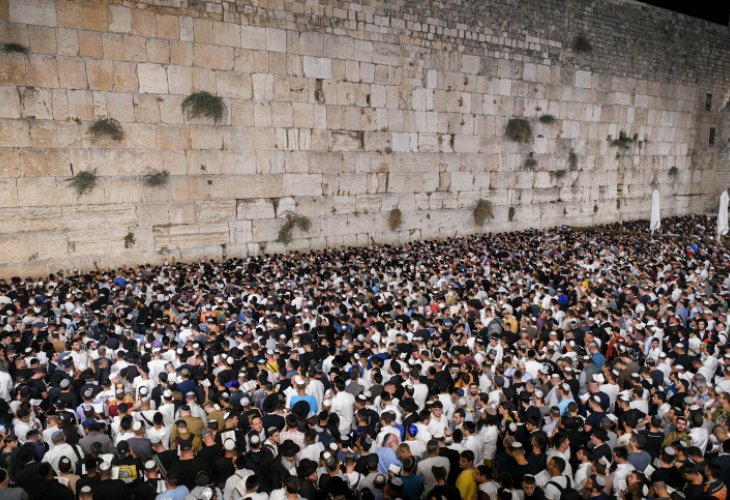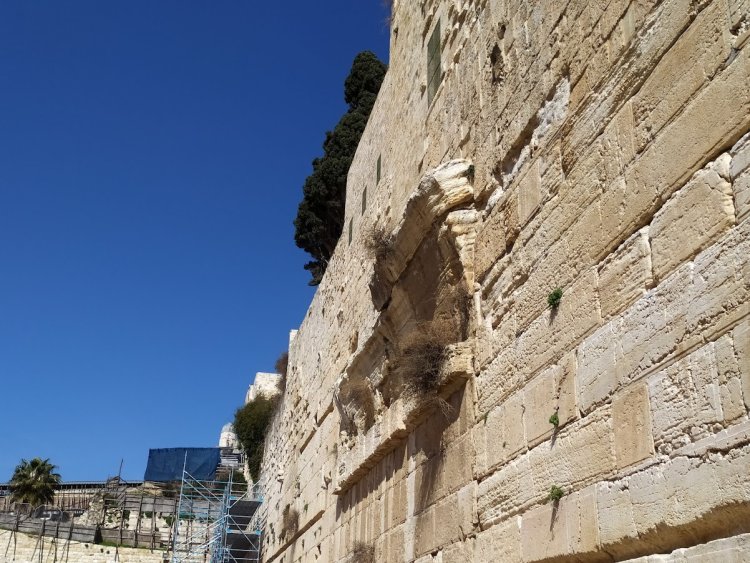History and Archaeology
The Western Wall: Secrets, Stones, and the Soul of Jerusalem
From Herod’s engineers to Ottoman sultans, from ancient arches to modern prayers — the story of Judaism’s most sacred surviving site
 The Western Wall (Photo: Arie Leib Abrams/Flash90)
The Western Wall (Photo: Arie Leib Abrams/Flash90)
The Western Wall — HaKotel HaMa’aravi — is one of the surviving sections of the retaining wall built by King Herod around the Temple Mount to expand its area. Herod filled the space between the new outer walls and the original mountain with vaulted chambers, creating a vast platform capable of supporting the magnificent Second Temple complex.
For example, the underground area known today as “Solomon’s Stables” is actually one of those vaulted spaces beneath the expanded platform.
A Tiny Plaza That Became a National Landmark
The Western Wall stretches for 488 meters (1,600 feet) in total.
Before the Six-Day War (1967), the prayer area — known in Arabic as Al-Buraq Alley — measured only 28 meters long and 3.6 meters wide. Jewish worshippers crowded into this narrow passage, often harassed by local residents.
After Jerusalem’s reunification in 1967, the Mughrabi Quarter, which had blocked access to the Wall, was cleared overnight, creating the large prayer plaza we know today, measuring about 57 meters in length. Over the years, the area has been further developed and renovated to accommodate the millions of people who visit annually.
The visible height of the Wall today is about 40 meters (131 feet), of which 15 meters are above ground and the rest buried below the plaza. Scholars estimate that in Herod’s time, the Wall reached a height of around 60 meters (197 feet).
The Herodian Stones and Later Additions
When you stand before the Wall, you can clearly see that not all stones are original. The seven lowest courses, made of enormous limestone blocks weighing tens of tons each, are from Herod’s period. Their distinctive margined edges, known as Herodian-style dressing, are still visible.
Above them, you’ll notice smoother, smaller stones added during the early Muslim period (around 1,300 years ago), and above those, even smaller stones from the Ottoman period.
Despite a common myth, Moses Montefiore did not add any of these upper layers. Modern analysis of the mortar between the top stones showed it contained materials invented long after Montefiore’s lifetime, disproving that legend.
The last documented elevation of the Wall likely took place about a century ago, during the late Ottoman or early British period. Interestingly, during the 1929 riots, Jews were accused of provoking Muslims by placing a divider for prayer. However, Rabbi Abraham Isaac Kook testified before the British commission that it was Muslim authorities who heightened the tension — literally, by adding the top layer of stones.
Arches, Bridges, and Discoveries
To the left of the prayer plaza, a covered area marks the entrance to the Western Wall Tunnels. The arch above it is known as Wilson’s Arch, named after the British officer who discovered it. Scholars believe it was part of an ancient bridge connecting the Temple Mount to the upper city of Jerusalem.
Farther south, a projection of stones known as Robinson’s Arch is visible. This was once part of a massive stairway interchange that led worshippers up from the street to the Temple Mount.
During excavations about 50 years ago, archaeologists found an inscription carved into one of the fallen stones reading: “And you shall see and your heart shall rejoice” (Yeshayahu 66:14).
The lettering dates from the Byzantine period, when one emperor considered allowing Jews to rebuild the Temple — and someone carved this hopeful verse to inspire them.
At the southwestern corner, two holes are visible — one in the southern wall and one in the western. A later Muslim tradition claims that this was the spot where the Prophet Muhammad tied his steed, Al-Buraq, giving the Wall its Arabic name.

The Earliest “Shabbat Siren”
Near this same corner, archaeologists discovered a stone inscribed “To the Place of Trumpeting”, believed to have fallen from the top of the Temple Mount when the Romans destroyed it. It likely marked the spot where priests blew the trumpets to announce Shabbat, as described in the Talmud (Shabbat 35b). The original stone is now in the Israel Museum, with a replica in its place.
From Ruin to Prayer
Even after the destruction of the Second Temple, Jews continued visiting the site. The Talmud (Makkot 24b) records the famous story of Rabbi Akiva and his colleagues visiting the ruins, where Akiva laughed through tears, seeing in the devastation a promise of redemption: “Akiva, you have comforted us.”
After the Bar Kokhba revolt, Jews were banned entirely from Jerusalem and permitted to pray there only once a year, on Tisha B’Av.
Travelers’ accounts from the 15th century onward describe Jews praying at the Wall. Scholars believe that the narrow alley used for prayer was widened following a major earthquake about 550 years ago, which brought down nearby structures.
A Sultan and a Clever Plan
A popular legend tells that about 500 years ago, when Sultan Suleiman the Magnificent conquered Jerusalem, he heard rumors of a sacred Jewish wall buried under heaps of garbage. To encourage the cleanup, he spread word that gold coins were hidden there. Crowds arrived to dig, and so the Wall was revealed.
During Ottoman rule, access to the Wall depended on the goodwill of local authorities, who sometimes charged money to pray there. Under British rule, formal regulations were set for worship.
“May We See the Rebuilding Soon”
Along the southern wall, archaeologists uncovered remnants of an ancient street lined with shops and numerous mikva’ot (ritual baths) used by pilgrims ascending to the Temple.
The Western Wall remains the heart of Jewish prayer and longing — the one surviving link between the physical world and the spiritual center of the Jewish people. “May we merit to see the rebuilding of the Third Temple, speedily in our days.”

